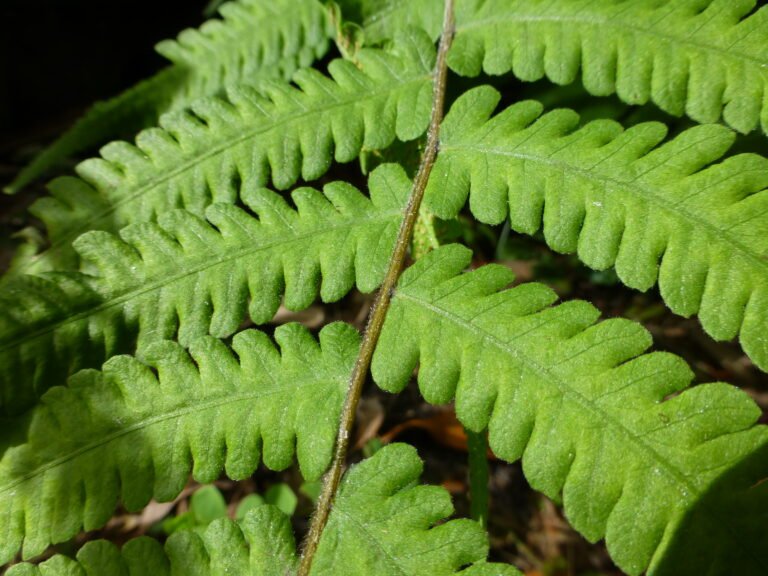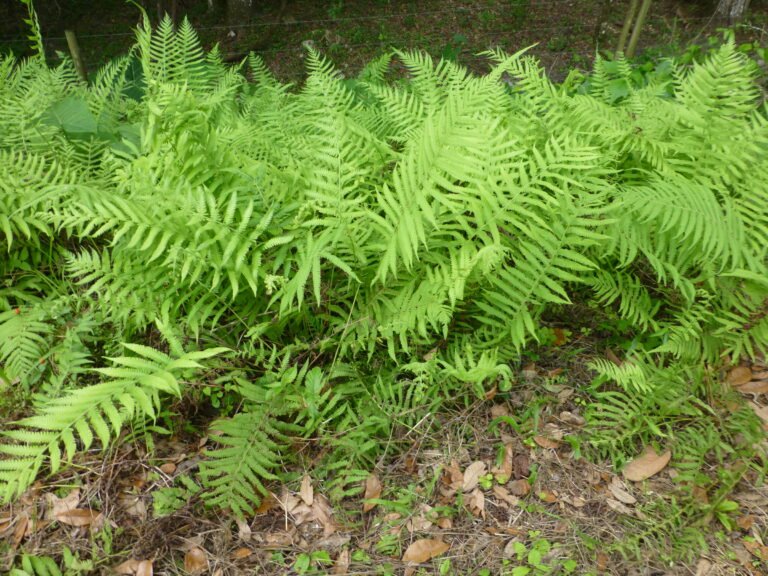
Osmundastrum cinnamomeum
(Cinnamon Fern)

Common Names, Latin Name, and Family
The only common name for this fern is cinnamon fern.
The Latin name is Osmundastrum cinnamomeum. It used to be called Osmunda cinnamomea.
It is found in the Osmundaceae, or royal fern, family.
Form
Cinnamon fern is a native, perennial, fern that is a dimorphic fern which means it has two distinct types of fronds, or leaves, one type being sterile and used for photosynthesis, and the other being fertile, and used for producing spores.
This fern does form clumps.
Leaves
Fronds (leaf): The leaves grow from 2 to 5 feet in height.
Petiole (leaf stalk): The petiole can be brown or green and grooved. When young it is covered with wooly, reddish-brown hairs.
Rachis (leaf stem): The rachis has brown wooly hairs when young but becomes smooth as it matures.
Blade (leaf blade): The sterile leaf blades are pinnate to pinnatifid and are 12 inches to 4 feet long. The overall shape is elliptic with 15 to 25 pairs of pinnae (leaflets).
The fertile blades grow to about 1 1/2 feet in height and are columnar in shape with copious masses of brown sporangia at the tips making them appear almost completely cinnamon colored.
Pinnae (leaflets): The leaflets are alternate on the leaf stems (rachis). The sterile pinnae are lobed, and lanceolate in shape.

Spores
The spores mature in mid to late summer.
The sori is the structure on the leaf that contains the sporangia. The sporangia are the individual structures that contain the spores.
On cinnamon fern the sori appear on fertile fronds that come up in straight column shaped fronds and are cinnamon in color.

Habitat
Cinnamon fern is found naturally occurring in moist sites such as boggy creek banks, stream banks, shaded ledges of rock sinks, and moist woodlands.
Native Range
Cinnamon fern (Osmundastrum cinnamomeum) is found naturally occurring in Florida from the panhandle south to Collier and Broward County.
It can be found in the following states: AL, AR, CT, DC, DE, FL, GA, IA, IL, IN, KY, LA, MA, MD, ME, MI, MN, MO, MS, NC, NH, NJ, NY, OH, OK, PA, RI, SC, TN, TX, VA, VT, WI, and WV.
Landscape Use
Cinnamon fern works great in moist shady areas of the landscape.
It is a wonderful fern grown in moist pockets of the landscape.
It is a clumping fern and can be contained so it is suitable for formal gardens, garden beds, and containers. It will spread by runners but much slower than most ferns, and the roots are generally shallow and easily pulled out, if they get overcrowded, and moved to other locations or shared with fellow gardeners.
Cinnamon fern works well as a border plant, or ground cover, in moist areas.
Their preferred sites are moist and shady, but they will grow in full sun as long as the soil is constantly moist. Occasionally the new fronds may get sunburned.

Wildlife Use
Ferns of all types provide hiding, and foraging, places for a variety of wildlife such as frogs, lizards, damsel flies, and dragonflies.
Deer do enjoy eating this fern.
According to this article it is not poisonous to cattle – https://www.fs.usda.gov/database/feis/plants/fern/osmcin/all.html.
Human Use
Many articles state that cinnamon fern fiddleheads are edible when cooked, however I would be cautious and see how you react after having a single bite. Please also be sure of your identification before eating any wild plants.
Wipe off the fuzzy hairs before cooking.
“Although we have found no reports of toxicity for this species, a number of ferns contain carcinogens so some caution is advisable [200]. Many ferns also contain thiaminase, an enzyme that robs the body of its vitamin B complex. In small quantities this enzyme will do no harm to people eating an adequate diet that is rich in vitamin B, though large quantities can cause severe health problems. The enzyme is destroyed by heat or thorough drying, so cooking the plant will remove the thiaminase [172].” [1]
Medicinal Uses
“A decoction of the root has been rubbed into affected joints as a treatment for rheumatism [257]. The root has been chewed, a small portion swallowed and the remainder applied to a snakebite [257]. The following reports do not state which part of the plant is being used, though it is most likely that the root is being referred to. The plant is analgesic, antirheumatic and galactagogue [257]. A decoction is used internally in the treatment of headaches, joint pain, rheumatism, colds, etc, and also to promote the flow of milk in a nursing mother [257].” [1]
Neither Plants For A Future, or the author of this article, can not take any responsibility for any adverse effects from the use of plants. Always seek advice from a professional before using a plant medicinally.

Propagation
Cinnamon fern transplants very well.
Transplanting will be successful if you obtain plants with sufficient roots, and if you can keep most of the original soil it’s an even better guarantee that it will survive. Small and large specimens will transplant well. If the plant is large remove most of the older, outer, fronds before moving it. Just trim them off as close to the main stem as possible.
Keep watered until new growth appears and then it should require zero maintenance.
Further Reading
The United States Forest Service has a great article called Fern Structure if you’re interested in learning more about ferns. Check out –
https://www.fs.usda.gov/wildflowers/beauty/ferns/structure.shtml#:~:text=Sori%20(singular:%20sorus)%20are,indusia%20(singular:%20indusium).
The University of Florida has a great article called Natural Area Weeds: Distinguishing Native and Non-Native “Boston Ferns” and “Sword Ferns” (Nephrolepis spp.)
Ferns of Florida: A Reference and Field Guide by Gil Nelson available at Amazon.